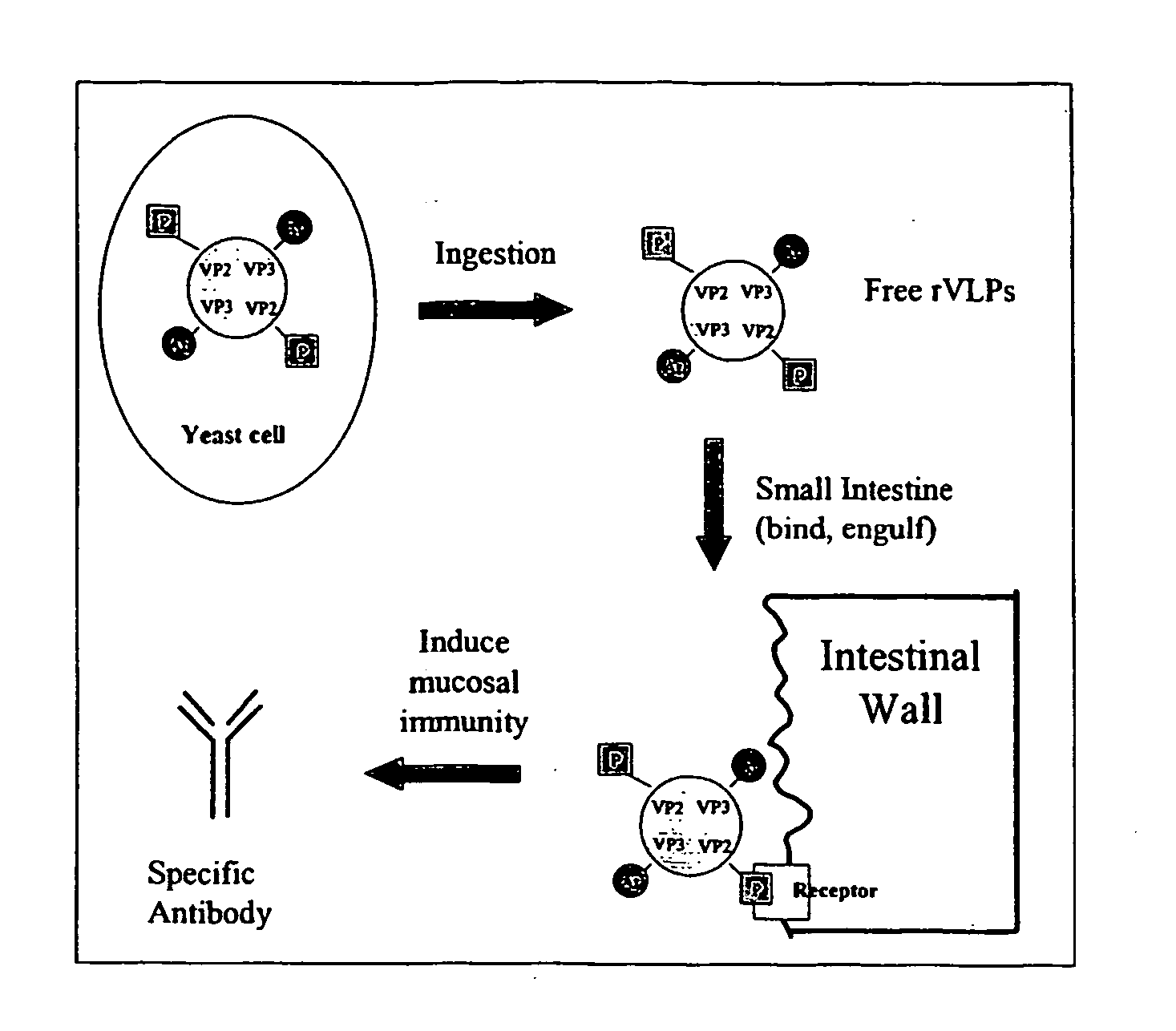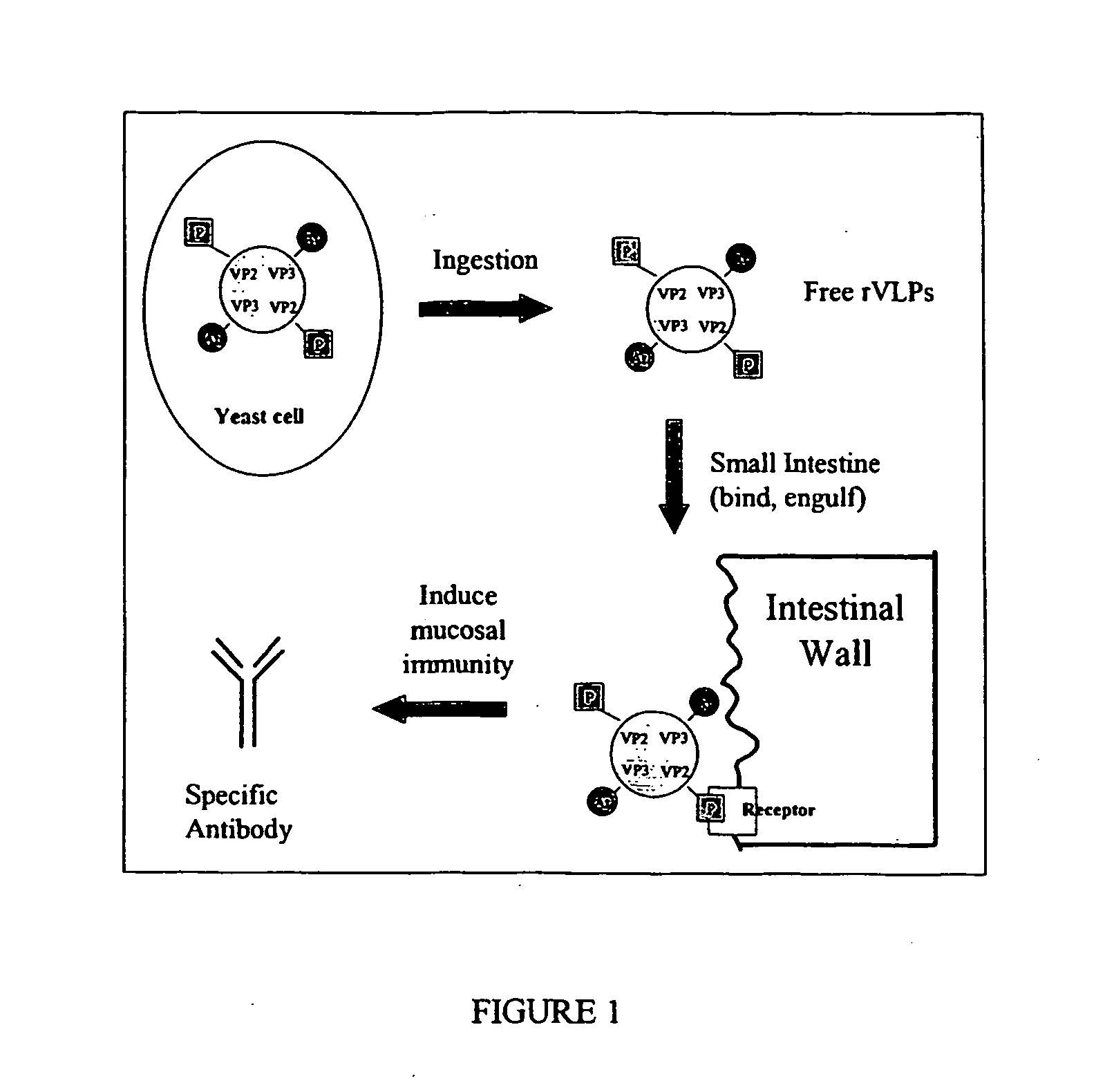Viruses and virus-like particles for multiple antigen and target display
a technology of viruses and viruses, applied in the field of molecular manipulation of viruses and viruslike particles, can solve the problems of reducing the ability to stimulate mucosal immunity, reducing the amount of antigen needed to produce a sufficient immune response, and encumbing current technology, so as to increase the potency of orally administered vaccines
- Summary
- Abstract
- Description
- Claims
- Application Information
AI Technical Summary
Benefits of technology
Problems solved by technology
Method used
Image
Examples
example 1
Recombinant IPNV Engineered to Have Attenuated Virulence But to Express Specific HIV-1 Epitopes for Use as an Oral Vaccine
[0030] The infectious pancreatic necrosis virus (IPNV) is made synthetically by methods described by Vakharia et al. (Yao and Vakharia, 1998). The cloned virus can be manipulated by normal methods (Sambrook et al., 1989) to change the genes to encode regions of a proteinaceous antigen as a fusion with a capsid protein, which has been done previously for virus-like particles (Welsh et al., 1999). In this case, the HIV-1 epitopes (Buonaguro et al., 2001) are cloned onto the orf (open reading frame) for IPNV structural proteins VP2 and VP3 in a position that, when expressed and properly processed, forms a fusion protein of one of the capsid proteins that does not prevent assembly of the capsid.
[0031] The recombinant virus, prepared as described in Vakharia and Yao, 2001, but containing HIV-1 antigen(s), is used to infect fish in a fish farm (e.g., brook trout). Th...
example 2
Recombinant Taura Syndrome Virus Expressing Antigenic Peptides as a Fusion with Viral Capsid Protein
[0032] Live recombinant viruses are made that contain antigenic peptide inserts in their capsid when assembled. An example is the use of Taura syndrome virus (TSV). This is a small virus that can be completely synthesized using existing molecular biological methods, e.g., PCR, from known sequence. A number of clones can be made that provide the entire genome and then specific sequence added that will allow a loop of antigenic material for a specific disease (e.g., parts of the hepatitis B surface antigen (Kong et al., 2001) to be exposed when the virus is allowed to infect its host.
[0033] In the example of rTSV, the virus is allowed to infect a tank containing shrimp such that the shrimp flesh will contain a large amount of the expressed virus. The shrimp flesh can then be used as an oral vaccine for hepatitis B. The use of live vaccines from non-human systems, such as the TSV, can ...
example 3
Purified Recombinant Attenuated Virus Used as a Vaccine Against HIV-1
[0034] HIV-1 epitope displayed on IPNV attenuated virus virions is isolated from the fish as infected from Example 1. The material is purified to homogeneity, tested for endotoxins, then aliquoted into sterile medium with or without adjuvant. This can then be utilized either as an oral or an injectable vaccine.
PUM
| Property | Measurement | Unit |
|---|---|---|
| resistance | aaaaa | aaaaa |
| homogeneity | aaaaa | aaaaa |
| structure | aaaaa | aaaaa |
Abstract
Description
Claims
Application Information
 Login to View More
Login to View More - R&D
- Intellectual Property
- Life Sciences
- Materials
- Tech Scout
- Unparalleled Data Quality
- Higher Quality Content
- 60% Fewer Hallucinations
Browse by: Latest US Patents, China's latest patents, Technical Efficacy Thesaurus, Application Domain, Technology Topic, Popular Technical Reports.
© 2025 PatSnap. All rights reserved.Legal|Privacy policy|Modern Slavery Act Transparency Statement|Sitemap|About US| Contact US: help@patsnap.com


